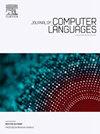Mental stress analysis by measuring heart rate variability during learning programming: Comparison of visual- and text-based languages
IF 1.8
3区 计算机科学
Q3 COMPUTER SCIENCE, SOFTWARE ENGINEERING
引用次数: 0
Abstract
Visual-based programming languages that facilitate block-based coding have gained popularity as introductory methods for learning programming. Conversely, programming experts typically use text-based programming languages like C and Java. Nevertheless, a seamless method for transitioning from a visual- to text-based language has yet to be developed. Therefore, our research project aims to develop a methodology that facilitates this transition by bridging the gap between the two languages and verifying the variations in the biometric information of learners of both languages. In this study, we measured the participants’ heart rate variability (HRV) and evaluated variations in mental stress experienced while learning visual- and text-based languages. The experimental results confirmed that participants proficient in text-based languages experienced lower HRV (indicating higher stress levels) when learning visual-based languages. Conversely, those poorly proficient in text-based languages exhibited higher HRVs (indicating more favorable stress levels) while learning text-based languages. This study successfully observed differences in stress levels while learning both language types using experimental methods. These findings serve as a preliminary step toward clarifying the impact of stress experienced during learning outcomes and identifying the factors that constitute beneficial stress. This study establishes a foundation for an intermediate language that can enhance transitions between the two types of languages.

通过测量学习编程过程中的心率变异性来分析精神压力:基于视觉和基于文本的语言的比较
促进基于块的编码的基于视觉的编程语言已经作为学习编程的入门方法而流行起来。相反,编程专家通常使用基于文本的编程语言,如C和Java。然而,一种从视觉语言到基于文本的语言无缝转换的方法还有待开发。因此,我们的研究项目旨在开发一种方法,通过弥合两种语言之间的差距并验证两种语言学习者生物特征信息的变化来促进这种转变。在这项研究中,我们测量了参与者的心率变异性(HRV),并评估了学习基于视觉和文本的语言时所经历的精神压力的变化。实验结果证实,精通基于文本的语言的参与者在学习基于视觉的语言时经历了更低的HRV(表明更高的压力水平)。相反,那些对基于文本的语言不熟练的人在学习基于文本的语言时表现出更高的hrv(表明更有利的压力水平)。本研究通过实验方法成功观察了两种语言学习过程中压力水平的差异。这些发现为澄清压力对学习结果的影响和确定构成有益压力的因素迈出了初步的一步。本研究奠定了中间语言的基础,可以促进两种语言之间的转换。
本文章由计算机程序翻译,如有差异,请以英文原文为准。
求助全文
约1分钟内获得全文
求助全文
来源期刊

Journal of Computer Languages
Computer Science-Computer Networks and Communications
CiteScore
5.00
自引率
13.60%
发文量
36
 求助内容:
求助内容: 应助结果提醒方式:
应助结果提醒方式:


